|
British Royal Standards since 1801 - Part 1
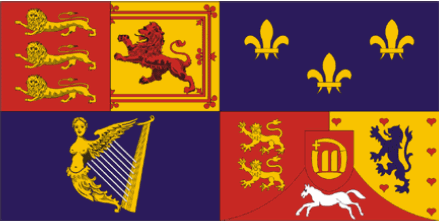 Last Royal Standard of the 18th Century 1714-1801 Last Royal Standard of the 18th Century 1714-1801
Royal Standard in the 19th Century
The Royal Standard in its present general arrangement dates from 1801 when the Anglo-Scottish first quarter and the Hanoverian fourth quarter became English, and the French second quarter became Scottish. The Irish third quarter was unchanged, and the position of King George III as Elector of Hanover was represented by an escutcheon of pretence in which a shield, charged with the Crown of Charlemage, was an escutcheon on the three-fold Arms of Brunswick, Luneburg and Hanover.
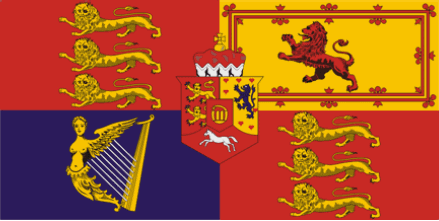 Royal Standard of 1816 Royal Standard of 1816 A change was made in 1816, when the Elector of Hanover became King of Hanover and the Electoral Bonnet ensigning Hanover was replaced by the Crown of Charlemagne. Hanover could not be ruled by a woman and when Queen Victoria acceded to the throne in 1837 the ensigned escutcheon of Hanover was removed.
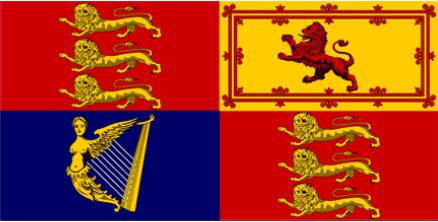 Royal Standard of 1837 Royal Standard of 1837 It is possible that these alterations were not in accordance with constitutional rules. In 1901 a Parliamentary Counsellor, referring to a proposed alteration which did not take place, wrote that under Article One of the Union with Ireland Act, 1800, the flags and banners of the newly created United Kingdom were to be appointed by Royal Proclamation. He added, "It is a well known constitutional rule that where a power is granted by Parliament to the Crown, that power is exhausted by its first exercise. In accordance with this constitutional rule the various alterations or additions which have been made to the Royal style and title have always been authorised by special legislation (eg. 39 & 40 Vict. c.10, and 1 Edw.7. c.15). It appears to me that any alteration of the Royal Standard, on which the Royal Arms are blazoned, would require similar legislation." The 1816 alteration was by Royal Proclamation of 8 June, announced in the London Gazette on 29 June and, according to Cumberland Clark in "Flags of Britain," (1934), that of 1837 by Royal Warrant.
[National Archives HO 45/10316/126525]
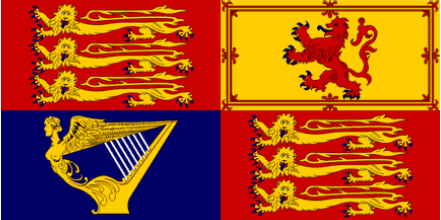 Royal Standard after 1907 Royal Standard after 1907Royal Standard after 1907
As with any Arms, representations of the Royal Arms do not all have to be identical, providing that they correspond with the blazon of the Arms, and conform to heraldic practice. Similarly the Royal Standard, which is a banner of the Royal Arms, does not have to be an exact copy of the Arms. Some conventions have become established. In 1906 Sir Alfred Scott-Gatty, Garter, King of Arms, criticized the appearance of the Royal Standard and offered to correct and improve its design, pointing out that the "lions of England and Scotland ought to be armed and langued azure." The charges were redrawn and enlarged, the lions given blue claws and tongues, and the tressure around the Scottish lion simplified. [ADM 116/1063C] He may also have standardized labels which could be either throughout (from hoist to fly) or couped (shorter), and the points straight, dovetailed, or with a flared tip. They were now usually throughout and straight.
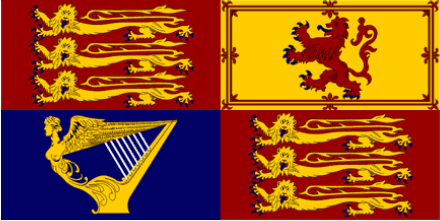 Royal Standard after 1937 Royal Standard after 1937Royal Standard after 1937
In about 1937 the colour red on the Standard was changed from red (T818A) to crimson (T816).
[ADM 1/9163]
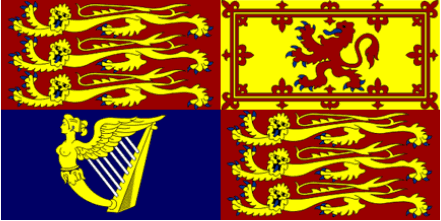 Royal Standard of 1957 Royal Standard of 1957Royal Standard 1957
In February 1957 Garter submitted a new version of the Royal Standard. It was approved by the Queen in July. The harp was a winged-female, but the lower half of the forepillar was the same as that usually seen on the Gaelic harp, rather than the elaborate swirls of the traditional winged-female harp. The tail of the Scottish lion was simplified, and four additional flowers added to a widened tressure. The already elongated English lions were stretched even further. In general the changes appear to have been made to follow the heraldic principle that a charge should cover as much of its field as possible, though the new winged-female harp is smaller than previous winged-female harps. It was probably at this time that bright yellow replaced the previous dull yellow. [WORK 21/214]
Harp on the Royal Standard
The harp appears in two different forms. On the Arms it is often a plain Gaelic harp, which fits neatly into the triangular space on the shield, but on the Standard the frame of the harp is usually in the form of a winged-female.
 Royal Standard with Gaelic Harp Royal Standard with Gaelic Harp In 1954 Queen Elizabeth II had expressed a preference for the Gaelic harp, and it was assumed that this style of harp would appear on all future Royal Standards. The 1956 edition of Flags of the World by H.Gresham Carr noted this with black and white drawings of both harps, while in the coloured illustration of the Royal Standard the harp was changed from the winged-female, that had appeared in the previous edition, to Gaelic. However when a revised Standard was introduced a year later, the harp was a winged-female. Some Gaelic harp Standards have been made. Undated photographs show a car flag, and a Standard flying at Windsor Castle, each with a Gaelic harp. The style of the Scottish quarter and the bright yellow colour suggest that they were made in 1957 or later.
[WORK 21/214]
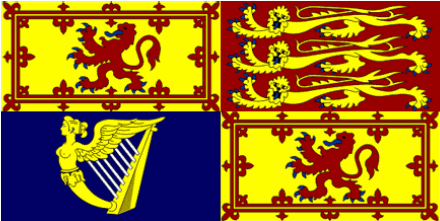 Royal Standard for use in Scotland Royal Standard for use in Scotland
[The Scottish Arms are in the first and fourth quarters, and the English Arms in the second quarter]Royal Standard for use in Scotland
In July 1911 the St Andrew Society asked that a "Scoto-British Royal Standard" should be flown at Holyrood House and Edinburgh Castle when the King was in residence during his visit to Edinburgh. The request was ignored, and in 1912 the Society passed a formal resolution asking that a flag with the quarterings of the Great Seal of Scotland should in future be flown by the Sovereign when in Scotland. The resolution was presented to the Commander-in-Chief, Scottish Command, and passed on to Buckingham Palace. The King's Private Secretary replied that the King had decided that the Royal Standard was the flag to be flown at any place within the Empire when HM was resident or visiting, as it was HM's personal flag. The President of the Society was dissatisfied because the reply had been passed to him verbally, and insisted upon a written reply. A formal letter was sent on 7 March 1912. The matter of a Scottish version of the Royal Standard was raised again in 1953 by the Secretary of State for Scotland. It was decided that since the Scottish version of the Royal Arms was used in Scotland there was no reason why a Scottish version of the Royal Standard should not similarly be used. [WO 32/16464]
Mourning
When Queen Victoria, King Edward VII and King George V died, one Royal Standard was flown normally by the succeeding Sovereign, and a second Royal Standard was flown at half-mast for the former Sovereign until the day of the funeral. When King George VI died in 1952, a Royal Standard was flown normally for Queen Elizabeth II, but the expected Royal Standard was not flown at half-mast on Victoria Tower when the body of the former King was lying-in-state in Westminster Hall. The official explanation for this new practice was that since the Crown is never extinct the Royal Standard should never be half-masted.
The same new practice was adopted when Queen Mary, consort of the late King George V, died in 1953. Her personal standard was struck and not flown at half-mast, although in 1925 the personal standard of Queen Alexandra, consort of the late King Edward VII, had been flown at half-mast from her death until the day of her funeral. In this case Garter, King of Arms, Sir George Bellew, contended that the dead could not fly flags, half-masted or otherwise.
[Journal of the Society for Nautical Research (Mariner's Mirror), August 1953, & February 1954]
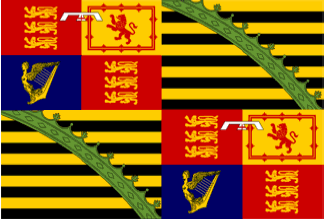 Standard of Albert, Prince Consort Standard of Albert, Prince Consort
[Royal Standard differenced by a three point label charged with one cross of St George, quartered with the Standard of Saxony]Albert, Prince Consort 1857 - 1861
The charge on the Arms of Saxony is a chaplet of rue, added when Emperor Frederick Barbarossa confirmed the Dukedom on Bernhard of Anhalt. Queen Victoria had married her cousin, Francis Albert, Duke of Saxony and Prince of Saxe-Coburg and Gotha, in 1840, but he was not granted the title Prince Consort until 1857, four years before his death.
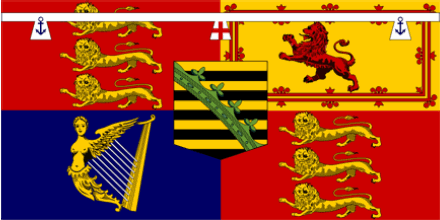 Standard of Alfred, Duke of Edinburgh Standard of Alfred, Duke of Edinburgh
[Escutcheon of Saxony on Royal Standard differenced by three point label charged with one cross of St George and two blue anchors]Alfred, Duke of Edinburgh 1873 (?) - 1893
Alfred, the Duke of Edinburgh, was the second son of Queen Victoria. It is usual to grant the offspring of the monarch the Royal Arms differenced by a label of three points for children and five points for grand-children. Before the 19th century banners of these differenced Arms were also granted. Although Arms were granted to Queen Victoria's children and grandchildren in the normal manner it seems that only two differenced banners of the Royal Arms were created, one for the Prince of Wales, and one for the Duke of Edinburgh. His Standard ceased to be a Standard of the British Royal Family when he succeeded to the Dukedom of Saxe-Coburg and Gotha in 1893. His Arms did not change and the Standard may have been used in the Dukedom
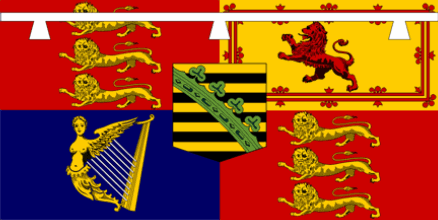 Standard of Edward, Prince of Wales Standard of Edward, Prince of Wales
[Escutcheon of Saxony on a Royal Standard differenced by a three point label]Edward, Prince of Wales
Edward, the Prince of Wales, was the eldest son of Queen Victoria, and later became King Edward VII. At the end of the 19th century the only member of the Royal Family with a distinctive Standard was Edward, Prince of Wales. The undifferenced Royal Standard was used by, not only Queen Victoria, but also by other members of the Royal Family. It was hoisted at military parades celebrating the Sovereign's Birthday, and flown on official buildings throughout the Empire on the Anniversaries of the Sovereign's Birthday, Coronation and Accession. It was also flown on government buildings when the Sovereign was passing in State, and by private individuals and organisations who thought that it was an appropriate way of displaying their loyalty to the crown.
The propriety of flying the Royal Standard was raised when preparations for the celebration of the 60th anniversary of the Queen's accession were planned in 1897. Those who asked the Home Office for permission to fly the Royal Standard, were told that only Her Majesty, members of the Royal Family, and certain Public Departments were entitled to fly the Royal Standard, but no action was taken against those who flew it.
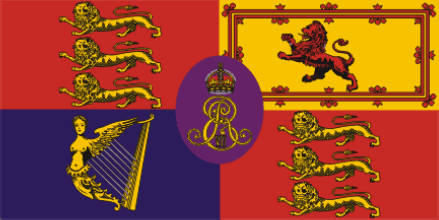 Proposed Personal Standard of King Edward VII Proposed Personal Standard of King Edward VII
[Royal Standard differenced with an oval shield in the centre carrying HRM's cypher and crown on a purple ground]Proposed Personal Standard of King Edward VII
When Edward succeeded Queen Victoria in 1901 he lost the use of the distinctive Standard of the Prince of Wales and had only the undifferenced, and quite widely used, Royal Standard. He therefore proposed that another special version of the Royal Standard should be created specifically for the Sovereign; "a Royal Standard differenced with an oval shield in the centre carrying HM's cypher and crown on a purple ground, for the King's exclusive and personal use alone, with misuse guarded against by the Patents, Design and Trade Mark Act of 1883. The cypher to be changed to that of the new sovereign on the demise of the previous sovereign." The King was persuaded that the proposal was impractical. If he invariably used the new Standard it would in effect become the Royal Standard, in which case the change would require legislation. It was anticipated that any change to the Royal Standard would be opposed, and that the neccessary legislation might not be passed by Parliament. Even if it was passed, the new Standard could still be copied and used by private individuals, as the Patent Act that was quoted, protected the Royal Arms and Standard only when used to advertise a trade, calling or profession.
In Scotland the Court of Lord Lyon could still legally challenge abuse of Scottish Arms, but the courts that had once protected English Arms and Bannners from misuse had long since lost their powers. The Court of Star Chamber was abolished in 1641, and the Court of Chivalry, of which the Constable of England and Earl Marshal were judges, became ineffective when the office of Constable was left vacant. The Court of Chivalry did sit in the 18th century, but following the judgement of the Chief Justice in 1702 that the Court had no powers to enforce its decrees, it dealt only with grants of Arms, and seems to have made no attempt to punish anyone for their improper use.
In 1902 an official in the Lord Chamberlain's Department wrote that "Any destruction of Arms or Banners that may have been done in recent times in England is probably of very questionable legality, and it would not be prudent to attempt by force to pull down even a Royal Standard improperly displayed on land. In fact, on land, the King's Standard is really without protection except so far as good feeling and good taste prevents its improper use. And an impression has even been produced that it is in some sense a national flag, and that people exhibit their loyalty to the King by displaying it. At common law there is nothing to prevent anyone using a flag. Every country gentleman who has Arms, might put them on a flag over his house. The only thing he may not do is to take the Arms of the King, or of some one else, or assume 'Arms' improperly. But even if he does so there appears no way of punishing him."
Following the failure to create a personal Standard for the Sovereign, Sir Albert Woods, Garter, King of Arms, suggested that, failing express permission, it was not proper for the Royal Standard to be displayed elsewhere than on a royal palace, or to denote the monarch's presence. In February 1902 it was announced that unlimited use of the Royal Standard would be permitted during the week of the Coronation (postponed from 26 June to 9 August due to the King's illness) but that subsequent use would be improper.
After the Coronation requests for permission to fly the Royal Standard were submitted to either the Home Office or the King's Private Secretary, but all the replies were channelled through the Home Office. A Home Office minute of 28 January 1903 set out the form of the standard reply. "Say that the Royal Standard is exclusively the the banner of the Sovereign. There have in the past been many instances in which, by mis-adventure or error, a custom has grown up of using it, but that when the question was raised recently it has become the duty of the Secretary of State to inform enquirers of what the rule really is. No exception is made in the case of any Borough or Corporation, or any other
bodies, whether royal or not."
[HO 45/10287/109071, HO 45/10316/126525, HO 144/602/B22911, & HO 144/7048]
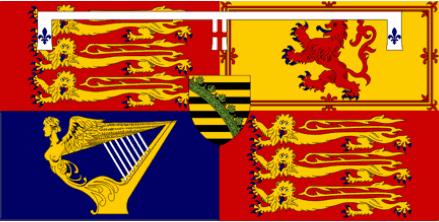 Standard of Arthur, Duke of Connaught Standard of Arthur, Duke of Connaught
[Escutcheon of Saxony on a Royal Standard differenced by a three point label charged with a cross of St George and two blue fleur-de-lis]Arthur, Duke of Connaught 1907 - 1917
Arthur, the Duke of Connaught, was the third son of Queen Victoria. The decision that the Royal Standard would cease to be used as an official flag, and would be used, with one exception, only to indicate the presence of the Sovereign necessitated the introduction of a new personal Standard for, Arthur, Duke of Connaught, who was about to undertake an official foreign tour.
Instructions to abandon the use of the Royal Standard for official purposes appear to have been uncoordinated, or only partially effective. The Admiralty Circular stating that the Royal Standard was not to be displayed on fortresses and official buildings was issued in August 1906, but other Circulars to implement these measures were issued, by the War Office in September 1906, the Home Office in June 1907, the Colonial Office in February 1908, and the Metropolitan Police in March 1908.
At the same time increased efforts were made to prevent use of the Royal Standard by private individuals and bodies. Circulars were sent to Police Forces explaining that although there was no law prohibiting use of the Royal Standard, it was the King's wish that it should not be flown without permission. The Scottish Office Circular of 16 March 1907, that informed Scottish Chief Constables of this, was followed by another Circular of 18 June saying that it did not apply to the Scottish lion. [ADM 116/1063C, HO 45/10316/126525, & MEPO 2/1070]
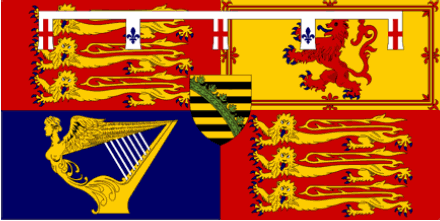 Standard of Arthur, Prince of Connaught Standard of Arthur, Prince of Connaught
[Escutcheon of Saxony on Royal Standard differenced by five point label charged with three crosses of St George and two blue fleur-de-lis]Arthur, Prince of Connaught 1907 - 1917
Prince Arthur of Connaught was the son of the Duke of Connaught. At this time enquiries were being received about using the Royal Standard as an indoor decoration. One such enquiry received the reply; "Although use of the Royal Arms in connection with any trade or business without permission is prohibited by statute, and although the displaying of the Royal Arms or Royal Standard in any public way except in accordance with heraldic usage is improper, their private use indoors for decoration purposes such as that which you propose is a matter to which
the Secretary of State does not think he can raise any objection."
The Royal Standard could also be hoisted at parades and ceremonies on the Sovereign's Birthday
even though the Sovereign was not present. This procedure was followed by the Army, Colonial Regiments, the Royal Air Force, and later by the Royal Navy for parades on land. In 1934 the Lord Chamberlain informed the Colonial Office that he felt sure that the Governor's Flag, if he was present, or the Union Jack, but not the Royal Standard, should be broken out at the masthead for the Royal Salute. This was incorrect, as King George V had confirmed on 9 July 1928 that the Royal Standard might be hoisted at his Birthday Parades, elsewhere than in London. It was normally hoisted during that part of the parade when the Sovereign, if attending, would have been present. The Royal Standard was also hoisted on 12 May 1937 and 2 June 1953 at parades celebrating the Coronations of George VI and Elizabeth II.
It is not known whether this practice is still carried out at military parades, but it has been reported that every year at the Queen's Birthday Parade in the Falkland Islands the Royal Standard is flown instead of the flag of the Governor while God Save the Queen is played.
[ADM 1/9131, CO 323/1272/9, & WO 32/14700]
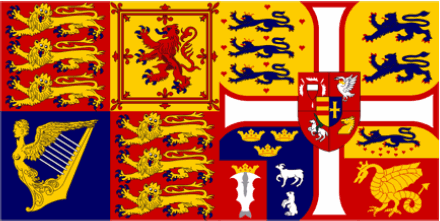 Standard of Queen Alexandra Standard of Queen Alexandra
[The Royal Standard, and her personal Standard as the daughter of King Christian IX of Denmark, impaled.]Queen Alexandra 1907 - 1925.
Queen Alexandra was the Consort of King Edward VII. Before their marriage, between 1863 to 1901, she had been the "Princess of Wales," which made her the person to have that title the longest in British history. Although after 1910, she was officially the Queen Mother (as the mother of the reigning monarch George V), she was usually called "Her Majesty Queen Alexandra."
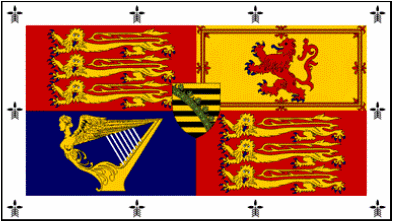 Standard for those members of the Royal Family without a Personal Standard Standard for those members of the Royal Family without a Personal Standard
[A Royal Standard having an escutcheon of the shield of Saxony, and a white border charged with ermine arranged,
one at each corner, two, top and bottom and one, hoist and fly]Other Members of the Royal Family
On 5 November 1907 an Admiralty Circular was published in "The Times." It stated that the King had approved the design of a Standard to be flown at sea by members of the Royal Family other than the King, Queen, Prince of Wales, Duke of Connaught, and Prince of Connaught. Unlike the Royal Standard, and unlike quartered, impaled or differenced versions of the Royal Standard, this flag is not, strictly speaking, a Banner of Arms since there is no Armorial Achievement which has a shield consisting of the Royal Arms with an ermine border. It is similar to a flag that had been first proposed in 1833. An Admiralty Circular of 4 July 1833 instituted the Admiralty Flag, Royal Standard, Union Jack combination for a ship carrying the King or Queen, but the first draft had proposed that a ship carrying the King and Queen should wear a Royal Standard alone, while one carrying only another member of the Royal Family should wear a white-bordered Royal Standard. [ADM 1/8765/311]
 Standard of Edward, Prince of Wales Standard of Edward, Prince of Wales
[Escutcheon of the Arms of Wales ensigned with a Ducal Coronet on the Royal Standard differenced by a three point label]Edward, Prince of Wales 1911 - 1936
Edward, the Prince of Wales, was the oldest son of King George V. King George V succeeded King Edward VII in 1910 and his son Edward was granted the title Prince of Wales. The opportunity was taken to modify the Standard of the Prince of Wales by replacing the shield of Saxony with a shield of the Arms of Wales ensigned with a Ducal Coronet.
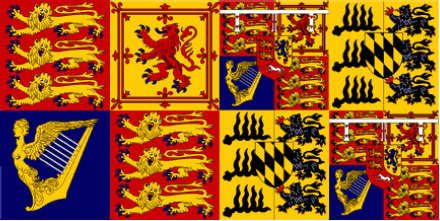 Standard of Queen Mary Standard of Queen Mary
[The Royal Standard, and her personal Standard as Victoria Mary, Princess of Teck, impaled]Queen Mary 1913 - 1953
Queen Mary was the Consort of King George V. In her personal Standard, the first and fourth quarters, the Arms of the Dukes of Teck, are the same as the British Royal Arms between 1801 and 1837, except that the inescutcheon of the Hanoverian Arms, (Brunswick, two lions passant guardant; Luneburg, lion and hearts; and Lower Saxony, horse), does not carry the central shield with the German Imperial Crown, and is not ensigned with the Electoral Bonnet or Royal Crown, items which belonged only to the head of the House of Hanover. In Britain the Arms are differenced with the label of the Dukes of Cambridge. They were granted to Adolphus Frederick, brother of King George IV, and passed to his daughter Mary Adelaide, who took them with her when she married Francis Paul, Duke of Teck. Their children combined the Cambridge Arms with those of Teck, which consisted of the Arms of Wurttenberg, "or, three deer antlers sable", impaled with those of Swabia, "or, three lions sable," with a black and gold lozengy inescutcheon, the Arms of Teck. The three black lions have red forepaws in memory of Duke Conradin of Swabia who at the age of sixteen was beheaded by Charles of Anjou in 1268. [Heraldry by O.Neubecker]
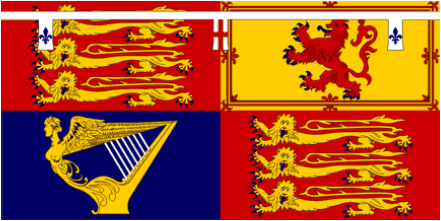 Standard of Arthur, Duke of Connaught Standard of Arthur, Duke of Connaught
[Royal Standard differenced by a three point label charged with one cross of St George and two blue fleur-de-lis]Arthur, Duke of Connaught 1917 - 1942
Queen Victoria had married Albert, Prince of Saxe-Coburg and Gotha. Consequently King George V, their grandson, had the family name Saxe-Coburg and Gotha. This became a source of controversy during the First World War, particularly in 1917 when London was bombed by German aircraft named Gotha. King George V renounced his family name and created the House of Windsor. The shield of Saxony was removed from the Standards of the Duke of Connaught, the Prince of Connaught and Other Members.
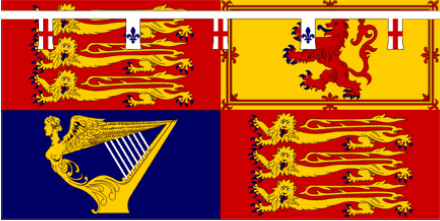 Standard of Arthur, Prince of Connaught Standard of Arthur, Prince of Connaught
[Royal Standard differenced by five point label charged with three crosses of St George and two blue fleur-de-lis.
The same as the 1907 Standard, but with the shield of Saxony removed.]Arthur, Prince of Connaught 1917 - 1938
Between 1920 and 1923, Arthur was also entitled to the flag of the Governor-General of the Union of South Africa. The general rule that anyone granted Arms may make a Banner of those Arms does not, as I understand it, apply to those granted differenced versions of the Royal Arms. The right to a Banner of differenced Royal Arms is subject to a separate grant. Had Prince Arthur not already had a differenced Royal Standard he would probably not have been granted one under new rules introduced by King George V when he established the House of Windsor. In order to avoid a proliferation of royal princes he issued Letters Patent under which only sons of the brothers of the Sovereign would be Princes with the style Royal Highness. Their children would inherit the same style as children of non-royal Dukes.
|